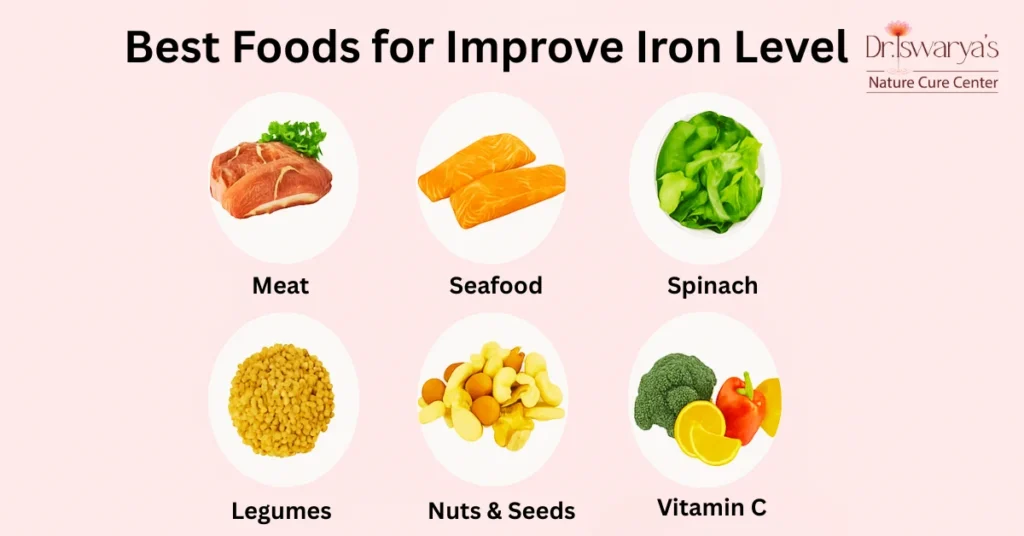Introduction
Feeling unusually tired, dizzy, or low on focus? It might be more than just a busy schedule — your body could be craving more iron. Choosing the right foods to improve your iron level can naturally restore your strength and boost your energy. From leafy greens and beans to red meat and seeds, the 8 best food for improve iron level can help you maintain healthy blood and oxygen flow. But balance is key — knowing the side effects of excessive iron intake helps you avoid overdoing it. Pairing the right foods and meal plans for iron deficiency ensures your diet supports vitality without causing harm, keeping your energy steady throughout the day.
About Rich Iron Foods
Understanding Iron-Rich Foods
Iron is an essential mineral that helps your body produce hemoglobin, the protein in red blood cells that carries oxygen throughout your body. Low iron can cause fatigue, weakness, and poor concentration. Choosing the right foods to improve your iron level helps maintain proper oxygen flow and keeps your energy steady all day.
Some of the 8 best food for improving iron level include leafy greens, red meat, fish, legumes, and fortified cereals. These options provide both heme and non-heme iron — the two main types — and are easily available in most local diets. Pairing them with vitamin C-rich foods also enhances absorption naturally.
Symptoms of Iron Deficiency
Recognizing Early Signs
Iron deficiency can develop slowly, often going unnoticed until symptoms worsen. Common signs include fatigue, pale skin, brittle nails, dizziness, and shortness of breath. If you experience frequent tiredness despite rest, it’s time to consider foods to improve your iron level in your diet.
When Iron Becomes Too Much
While increasing iron intake is beneficial for deficiency, it’s crucial to understand the side effects of excessive iron intake. Too much iron can cause nausea, constipation, and in severe cases, liver damage. Maintaining balance through moderate portions and professional guidance is the key.
People often focus on boosting iron but overlook the risks of over-supplementation — so always aim for a healthy middle ground.
When to See a Doctor
Knowing When to Seek Help
If fatigue, dizziness, or weakness persist even after adding foods to improve your iron level, consult a doctor for a blood test. Medical professionals can determine if you have iron deficiency anemia or another underlying issue.
Supporting Your Diet
Doctors often recommend customized foods and meal plans for iron deficiency that balance nutrient intake while preventing overconsumption. Even though dietary changes can help, some cases might require iron supplements. Listening to your body and getting regular checkups ensures safe and effective management.
Remember, professional guidance complements — not replaces — the benefits of natural foods.
8 Best Food for Improve Iron Level
1. Spinach
A leafy green powerhouse packed with non-heme iron and vitamins that improve energy. Adding spinach to soups, curries, or smoothies supports foods to improve your iron level naturally.
2. Red Meat
One of the richest sources of heme iron that’s easily absorbed by the body. Including lean cuts twice a week is part of the 8 best food for improve iron level list.
3. Lentils
A vegetarian’s favorite — lentils are high in protein, fiber, and iron. Pairing them with vitamin C-rich foods enhances absorption.
4. Pumpkin Seeds
These crunchy seeds are an excellent snack that helps maintain hemoglobin levels and support energy production.
5. Chickpeas
Loaded with iron and plant-based protein, chickpeas are versatile and ideal for salads or curries.
6. Tofu
A staple for vegetarians, tofu provides iron and calcium while supporting overall muscle health.
7. Eggs
Eggs supply moderate amounts of iron and work best when part of balanced breakfasts or light meals.
8. Fish
Fish like sardines and tuna are excellent sources of iron and omega-3 fatty acids — both crucial for heart and blood health.

Including these foods to improve your iron level daily can gradually restore vitality and prevent anemia.
Side Effects of Excessive Iron Intake
Why Too Much Iron Can Be Harmful
Although iron is vital, taking it in excess can be dangerous. Consuming high doses or unnecessary supplements may cause constipation, nausea, abdominal pain, or even liver complications. Maintaining moderation is essential while choosing foods to improve your iron level.
Doctors often design foods and meal plans for iron deficiency that ensure safe intake levels. Always check with a healthcare provider before taking additional supplements, especially if you already have balanced iron levels.
Types of Iron
Heme vs. Non-Heme Iron
There are two main types of iron your body absorbs — heme iron (from animal sources) and non-heme iron (from plant sources). Understanding both helps tailor your foods to improve your iron level effectively.
While heme iron is easily absorbed, non-heme iron benefits from being paired with vitamin C-rich foods. However, consuming excessive heme iron can increase the side effects of excessive iron intake, such as digestive distress or oxidative stress. Balance remains the cornerstone of good nutrition.
Conclusion
Maintaining optimal iron levels is essential for your energy, immunity, and overall well-being. Choosing the right foods to improve your iron level — from greens to lean proteins — helps prevent fatigue and supports your body’s natural vitality. A balanced diet, combined with regular health checks, ensures you get just the right amount of iron without risking excess. Remember, mindful eating and awareness are your best tools for lasting strength and good health.
Read also: Tips to Help You Lose Weight Naturally
